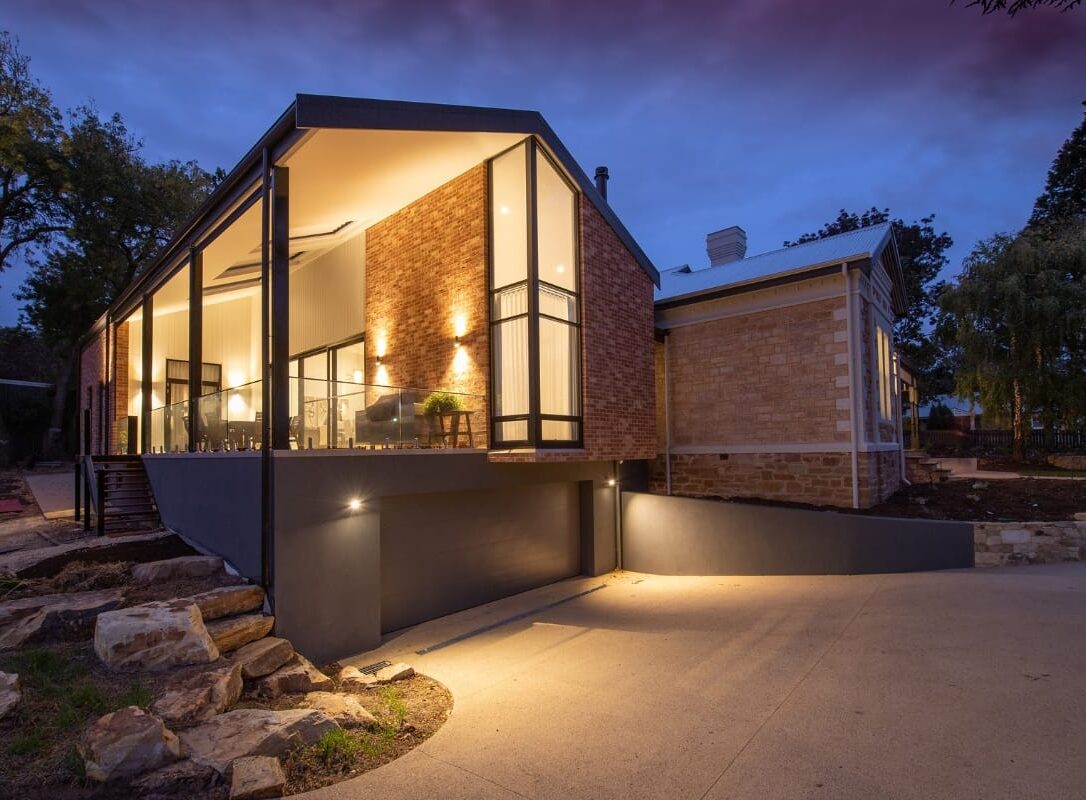Is your home’s exterior shrouded in darkness at night, making you feel vulnerable to potential security threats? Expert landscape lighting design can transform your property into a well-lit, secure haven.
This article will guide you through the key principles of landscape lighting design for safety, including selecting the right techniques and fixtures.
You’ll learn how professional installation can enhance your home’s security, and how to maintain your lighting system for long-lasting protection. Discover how to illuminate your outdoor spaces effectively, deterring intruders and creating a safer environment for your family.
The Ultimate Guide to Landscape Lighting Design for Every Home
The Importance of Landscape Lighting in Home Safety and Security
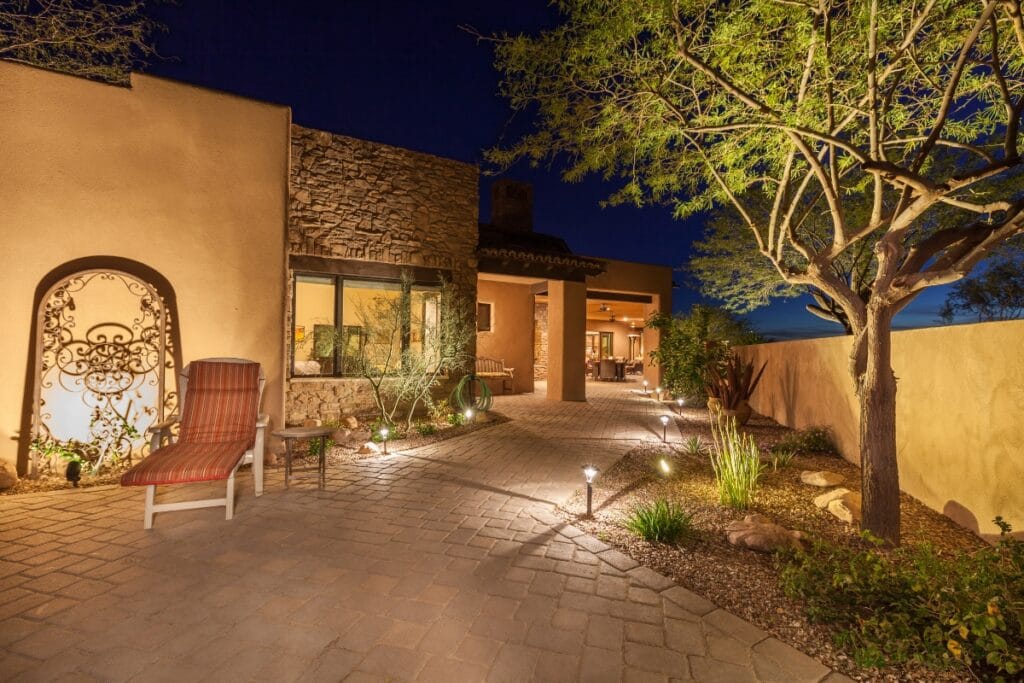
Your landscape lighting design plays a crucial role in home safety and security. Proper lighting deters intruders, illuminates entry points, and prevents accidents on pathways and stairs.
By improving nighttime visibility around your home, you create a safer environment for your family and guests. From water features to garden paths and tree lighting, a well-designed landscape lighting system enhances both the beauty and security of your outdoor space.
Deterrent Effect of Proper Lighting on Intruders
When you install proper landscape lighting, you create a powerful deterrent against potential intruders. By strategically placing LED lamps around your property, you illuminate dark corners and entryways, making it difficult for unwanted visitors to approach unseen.
The right combination of hardscape lighting and electric lights can create a well-lit perimeter that discourages criminal activity.
Your landscape lighting design should focus on key areas like entry points, walkways, and hidden spots around your home. By using a transformer to control multiple light fixtures, you can ensure consistent illumination throughout your property.
Remember, it’s not just about brightness – the right lumen output and placement of lights can create an effective security barrier without overwhelming your outdoor aesthetics.
Illuminating Entry Points for Enhanced Security
When you illuminate entry points around your home, you create a welcoming space while boosting security. Strategically placed lights near doors and windows cast away shadows, making it harder for intruders to hide. This lighting approach not only enhances your home’s aesthetics but also acts as a deterrent, keeping unwanted visitors at bay.
Consider incorporating patio lighting into your security plan. By extending illumination to outdoor living areas, you create a seamless transition between indoor and outdoor spaces.
This not only improves the functionality of your patio but also increases overall safety. Remember to use energy-efficient LED bulbs to minimize electricity consumption while maximizing the security benefits of your landscape lighting.
Preventing Accidents by Lighting Pathways and Stairs
You can prevent accidents by lighting pathways and stairs in your landscape. By running wire along your lawn and deck edges, you’ll illuminate potential tripping hazards. This not only enhances safety but also adds a warm glow to your outdoor space, making it more inviting after dark.
When planning your lighting, consider the heat generated by fixtures near plants. Choose LED options that stay cool to protect your greenery while providing ample illumination.
By strategically placing lights along stairs and walkways, you’ll create a safe and beautiful outdoor environment for you and your guests to enjoy.
Improving Nighttime Visibility Around Your Home
Improving nighttime visibility around your home starts with strategic lighting placement. You can enhance safety and beauty by installing motion detectors at key points, such as entryways and dark corners.
These smart devices not only alert you to movement but also provide instant illumination when needed, deterring potential intruders and preventing accidents.
Consider the color temperature of your outdoor lights to create the right ambiance while maintaining visibility. Warm brass fixtures can add a touch of elegance to your walls while providing sufficient light.
By carefully selecting and positioning your lighting fixtures, you’ll create a welcoming and secure environment that extends your living space into the night.
- Install motion detectors at key points
- Choose appropriate color temperature for ambiance and visibility
- Use brass fixtures for elegance and functionality
- Position lights strategically to deter intruders and prevent accidents
Key Principles of Expert Landscape Lighting Design
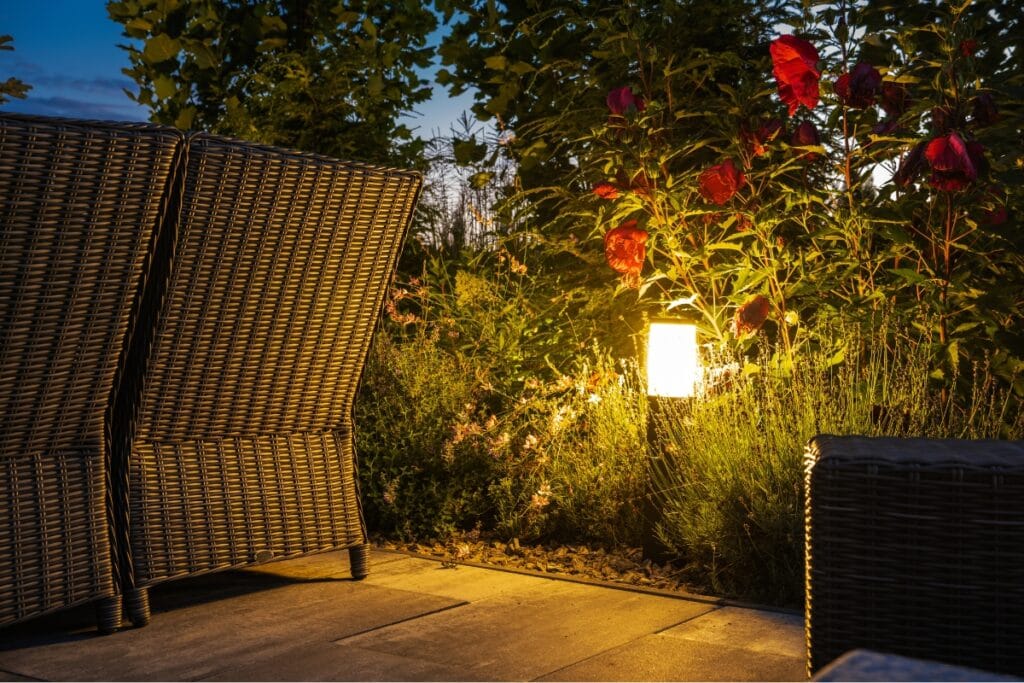
When designing your landscape lighting, you’ll need to balance aesthetics with security needs. Strategic placement of fixtures, from bollards to floodlights, is key.
You’ll want to minimize glare and light pollution while incorporating energy-efficient solutions. Consider voltage options and bulb types for your driveway and other areas to create a safe, attractive outdoor space.
Balancing Aesthetics With Security Needs
When balancing aesthetics with security needs in your landscape lighting design, consider using path lights that serve a dual purpose.
These fixtures can illuminate walkways to prevent trips and falls while deterring burglary attempts. Choose volt landscape lighting systems that offer both beauty and functionality, ensuring your outdoor display remains attractive without compromising safety.
To maintain the visual appeal of your lighting setup, opt for corrosion-resistant fixtures that withstand outdoor elements. This not only preserves the aesthetic quality of your landscape but also ensures long-lasting security benefits.
Remember, strategically placed lights can create stunning visual effects while simultaneously enhancing your home’s safety features.
Strategic Placement of Lighting Fixtures
When strategically placing lighting fixtures, you’ll want to consult an electrician to ensure proper installation and wiring.
Consider using sensors to activate lights when needed, reducing light pollution and energy consumption. By carefully positioning fixtures, you can create the right ambiance while maintaining security.
Choose fixtures that direct light beams where needed, minimizing glare and maximizing visibility. Experiment with different color temperatures to enhance your landscape‘s features and create depth.
Remember, strategic placement isn’t just about security; it’s about crafting a beautiful nighttime scene that complements your home’s architecture.
Minimizing Glare and Light Pollution
When designing your landscape lighting, focus on minimizing glare and light pollution to enhance safety without compromising the environment.
Use low voltage fixtures with shielded bulbs to direct light downward, reducing unwanted glare and preserving the night sky. This approach not only improves accessibility but also conserves energy, creating a more eco-friendly outdoor space.
Consider incorporating silhouette lighting techniques to highlight key features while maintaining a soft ambiance. This method can effectively deter crime by illuminating potential hiding spots without creating harsh shadows.
By carefully balancing light levels and placement, you’ll create a secure environment that respects your neighbors and local wildlife:
- Use shielded fixtures to reduce glare
- Implement low voltage systems for energy efficiency
- Incorporate silhouette lighting for subtle security
- Balance light levels to minimize pollution
Incorporating Energy-Efficient Solutions
You can incorporate energy-efficient solutions in your landscape lighting design by using low-watt LED bulbs for your walkway and property lighting.
These bulbs consume less power while providing ample illumination, reducing your energy costs and environmental impact. Consider installing motion sensors on key fixtures to ensure lights activate only when needed, further conserving energy.
To enhance your property‘s aesthetic appeal and energy efficiency, consider solar-powered lights for areas like your fountain or garden paths.
These fixtures harness sunlight during the day and illuminate your outdoor spaces at night without drawing from the electrical grid. By combining various energy-efficient lighting solutions, you create a sustainable and secure outdoor environment:
- Use low-watt LED bulbs for walkways and general property lighting
- Install motion sensors on key fixtures
- Incorporate solar-powered lights for decorative features
- Combine different energy-efficient solutions for optimal results
Selecting the Right Lighting Techniques for Your Property
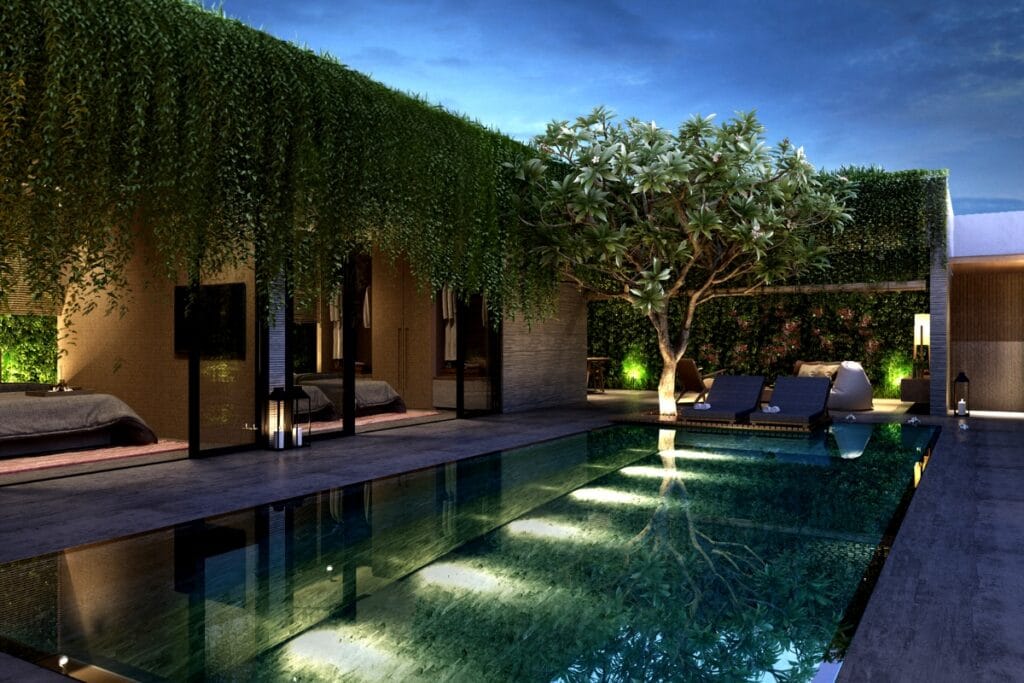
When selecting lighting techniques for your property, focus on enhancing safety and security while creating visual appeal. Consider using spotlights to highlight landscape features, floodlights for wide area coverage, and path lights for safe navigation.
Implementing motion-activated lights and integrating smart lighting controls can further boost security. By addressing voltage drop and power supply issues, you’ll create an effective crime prevention system with improved visibility and home automation options.
Highlighting Landscape Features With Spotlights
You can use spotlights to highlight key landscape features, enhancing both security and aesthetics. By focusing light on stairs, architectural elements, or unique shrubs, you create visual interest while improving visibility. This technique not only deters intruders but also showcases your property‘s best attributes.
When placing spotlights, consider the texture and shape of leaves to create captivating shadows. You might use a sconce to illuminate a wall near an entrance, combining functionality with artistic flair.
Remember to adjust the beam angle and intensity to avoid harsh glare while still providing adequate illumination for safety.
Using Floodlights for Wide Area Coverage
You can use floodlights to cover wide areas of your property, providing excellent security and visibility. When installing floodlights, consider the electrical wiring requirements and opt for copper wiring for durability.
These powerful fixtures can illuminate large spaces like driveways, backyards, or the perimeter of your home, deterring potential intruders.
For a more aesthetically pleasing option, consider using lantern-style floodlights that add dimension to your landscape while serving a functional purpose.
You can combine floodlights with accent lighting to create a layered lighting design, enhancing both security and curb appeal. Remember to position floodlights strategically to minimize light pollution and maximize coverage:
Installing Path Lights for Safe Navigation
When installing path lights for safe navigation, consider how they’ll look in daylight as well as at night.
Choose fixtures that complement your landscape design during the day and provide adequate illumination after dark. Pay attention to the shape and angle of the light to create a cohesive atmosphere throughout your outdoor space.
You can enhance safety by placing lights at key points along walkways, steps, and near potential hazards. Adjust the angle of each fixture to minimize glare and maximize visibility.
Remember, the goal is to create a welcoming atmosphere while ensuring safe passage for you and your guests.
Implementing Motion-Activated Lights for Added Security
You can enhance your home’s security by implementing motion-activated lights along your sidewalk and other key areas. These lights, often available in elegant bronze finishes, provide an effective deterrence against potential intruders.
When selecting motion sensors, consider their volt rating and brightness levels to ensure optimal performance and energy efficiency.
To maximize the effectiveness of your motion-activated lighting system, strategically place sensors to cover vulnerable entry points and dark corners.
Adjust the sensitivity and duration settings to avoid false triggers while maintaining adequate illumination when needed. This approach not only improves security but also contributes to energy savings by activating lights only when necessary:
Integrating Smart Lighting Controls
You can integrate smart lighting controls to enhance your landscape‘s safety and efficiency. By using LED bulbs with adjustable color temperatures, measured in Kelvin, you’ll create the perfect ambiance while maintaining security.
Mount these smart fixtures in your gardens and along pathways to automate lighting based on time, motion, or weather conditions.
With smart controls, you can easily adjust your outdoor lighting remotely. This allows you to simulate occupancy when you’re away, deterring potential intruders.
You can also program your lights to gradually brighten as the sun sets, ensuring your landscape remains well-lit and safe throughout the evening:
Choosing the Best Lighting Fixtures for Security
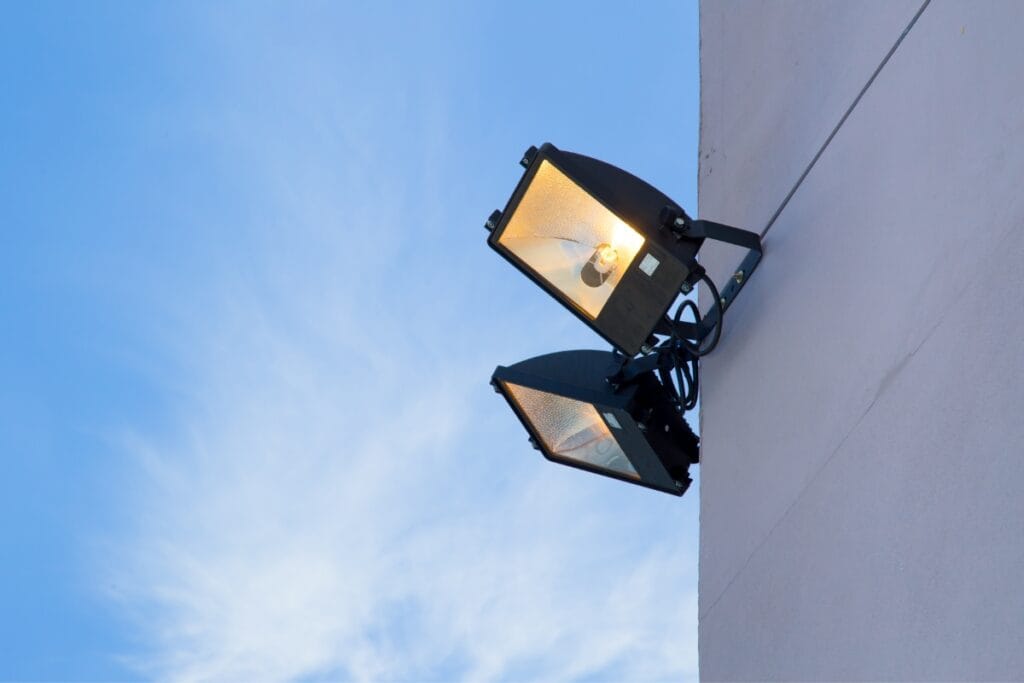
When choosing lighting fixtures for your outdoor space, you’ll want to focus on both security and style. Consider weather-resistant materials, appropriate brightness levels, and LED options for longevity.
Ensure your fixtures are tamper-proof and match your home’s style. These choices will enhance your landscape architecture while improving security through smart outdoor lighting design.
Opting for Weather-Resistant Materials
When selecting lighting fixtures for your outdoor living space, opt for weather-resistant materials to ensure longevity and performance.
Choose luminaires made from durable metals like brass or stainless steel, which can withstand harsh weather conditions and maintain their appearance over time. These materials protect the internal components of your landscape lighting systems, ensuring they continue to function effectively in rain, snow, or intense sunlight.
Consider the IP rating of your outdoor lighting fixtures, which indicates their level of protection against water and dust ingress. For landscape lighting systems exposed to direct rainfall or sprinklers, look for fixtures with an IP65 rating or higher.
This ensures your lighting remains safe and functional, enhancing both the security and aesthetics of your outdoor space year-round.
Selecting Appropriate Brightness Levels
When selecting appropriate brightness levels for your landscape lighting, consider the specific needs of each area. For pathways and entryways, use moderate brightness to ensure safety without creating harsh glare.
Kichler landscape lighting offers a range of options that can be dimmed or brightened as needed, allowing you to adjust the intensity based on time of day or specific security concerns.
For accent lighting and decorative features, opt for lower brightness levels to create a subtle ambiance. Hinkley outdoor lighting provides elegant solutions that balance aesthetics with security.
Remember to layer your lighting, using a combination of bright and soft lights to create depth and enhance overall visibility in your yard:
- Use brighter lights for security-critical areas like entrances
- Choose softer lighting for decorative elements
- Layer different brightness levels for a balanced outdoor lighting design
- Consider dimmable options for flexibility
Considering LED Options for Longevity
When considering LED options for your landscape lighting, you’ll benefit from their longevity and energy efficiency. Kichler outdoor lighting offers a range of LED fixtures that can last up to 50,000 hours, reducing the need for frequent replacements.
These modern outdoor lighting solutions not only enhance security but also minimize maintenance costs over time.
You can choose from various volt outdoor lighting options, including low voltage landscape lighting systems that are safe and easy to install.
For areas without easy access to electricity, solar landscape lighting provides a sustainable alternative. By incorporating LED technology into your outdoor lighting design, you’ll create a well-lit, secure environment that stands the test of time:
- Choose long-lasting LED fixtures for reduced maintenance
- Opt for low voltage systems for safety and ease of installation
- Consider solar-powered options for remote areas
- Select fixtures with adjustable brightness for versatility
Ensuring Fixtures Are Tamper-Proof
When selecting outdoor landscape lighting fixtures, prioritize tamper-proof designs to enhance security. Choose low voltage lighting systems with concealed wiring and secure mounting mechanisms to deter vandalism.
LED landscape lighting fixtures with shatterproof lenses and tamper-resistant screws offer both durability and protection against interference.
For step lights and commercial outdoor lighting, opt for robust fixtures designed to withstand potential tampering. Look for models with hidden fasteners and reinforced housings to ensure they remain securely in place.
By selecting tamper-proof fixtures, you’ll create a reliable lighting system that maintains its integrity and effectiveness in enhancing your property‘s safety:
Matching Fixtures With Your Home’s Style
When selecting the best landscape lighting for your home, choose fixtures that complement your architecture and enhance security.
Opt for hardscape lighting that blends seamlessly with your home’s exterior, such as copper path lighting for a traditional look or sleek LED fixtures for a modern aesthetic. This approach ensures your outdoor lighting design not only improves safety but also boosts curb appeal.
For a cohesive look, consider incorporating solar flood lights or outdoor flood lights that match your home’s style. You can find fixtures in various finishes and designs that work well with different architectural elements.
By carefully selecting fixtures that align with your home’s character, you create a harmonious outdoor lighting scheme that enhances both security and visual appeal.
With the right fixtures chosen, you face a choice. Install them yourself or call in the pros?
Professional Installation vs. DIY Approaches
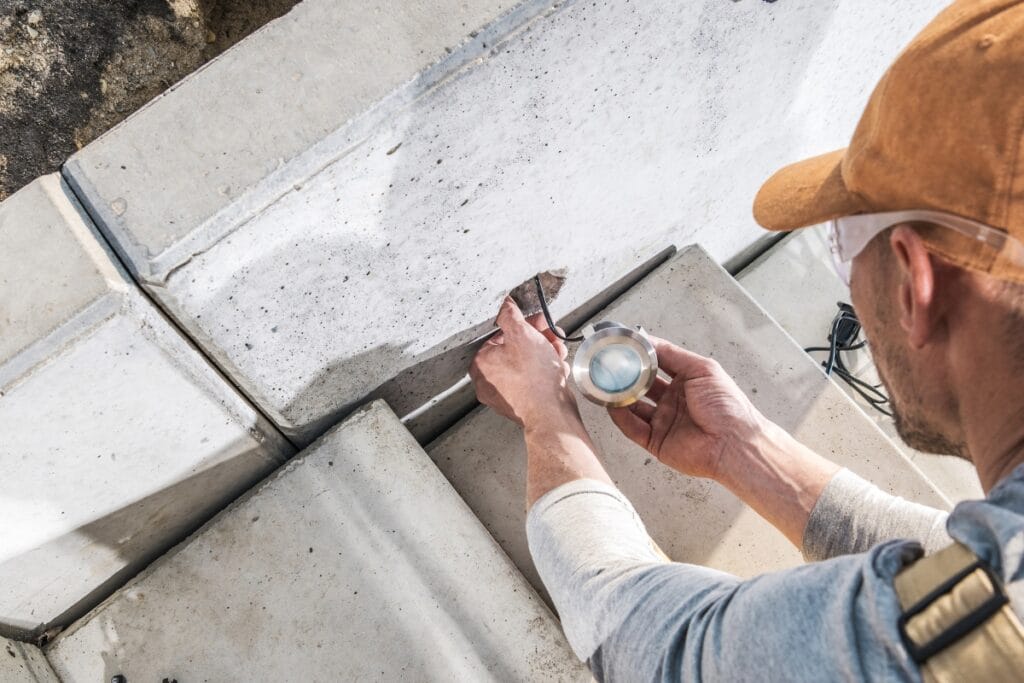
When deciding between professional installation and DIY for your landscape lighting, consider several factors. We’ll explore the benefits of hiring experts, electrical safety requirements, project complexity, cost comparisons, and maintenance needs.
Whether you’re installing solar security lights, outdoor LED flood lights, or sensor lights, understanding these aspects will help you make an informed decision for your home’s safety and security.
Benefits of Hiring Landscape Lighting Experts
When you hire landscape lighting experts, you gain access to their specialized knowledge of security lights and motion detector lights. These professionals can strategically place motion lights outdoors to maximize coverage and deter potential intruders.
They understand the optimal positioning for solar motion lights and solar powered security lights, ensuring your property remains well-lit and secure throughout the night.
Expert installers can integrate various lighting technologies seamlessly, creating a comprehensive security system tailored to your property‘s unique needs.
They can advise you on the best combination of motion-activated and constant lighting, helping you achieve a balance between energy efficiency and safety. With their expertise, you’ll get a professionally designed lighting layout that enhances both the security and aesthetic appeal of your outdoor space.
Understanding Electrical Safety Requirements
When considering outdoor security lights, you need to understand electrical safety requirements to protect yourself and your property.
Proper installation of a security flood light or motion-activated flood light involves following local electrical codes and using appropriate weatherproof materials. You’ll need to ensure correct voltage, wiring, and grounding to prevent electrical hazards and maintain the longevity of your lighting system.
For DIY installations, familiarize yourself with basic electrical concepts and safety practices. However, if you’re unsure about any aspect of the installation process, it’s best to consult a professional.
They can help you select the right fixtures, determine proper placement, and ensure all electrical connections are secure and up to code. Remember, safety should always be your top priority when working with outdoor electrical systems:
- Research local electrical codes and permits
- Use weatherproof materials and connections
- Ensure proper voltage and grounding
- Consider professional help for complex installations
Assessing the Complexity of Your Project
When assessing the complexity of your landscape lighting project, consider the size of your property and the number of fixtures you’ll need.
If you’re dealing with a small area and only require a few lights, you might tackle it yourself. However, for larger properties or intricate designs involving multiple lighting zones, you’ll likely benefit from professional expertise.
Evaluate your technical skills and comfort level with electrical work. Simple solar-powered lights are easier to install, but wired systems require more knowledge.
If your project involves integrating smart controls or addressing challenging terrain, you might want to hire a pro. They can navigate complex installations while ensuring your lighting design enhances both safety and aesthetics.
Cost Comparison and Budget Considerations
When comparing costs between professional installation and DIY approaches for your landscape lighting, consider both upfront expenses and long-term savings.
Professional installation may have a higher initial cost, but it often includes high-quality fixtures and expert design that can increase your property‘s value. DIY projects might seem cheaper at first, but you’ll need to factor in the cost of tools, potential mistakes, and your time investment.
Your budget should account for ongoing maintenance and energy costs. Professional installations often use energy-efficient LED lights and smart systems that can lower your electricity bills over time.
If you choose the DIY route, research energy-saving options and calculate the long-term costs of replacement bulbs and fixtures. Remember, a well-designed lighting system can enhance your home’s security and curb appeal, potentially offering a good return on investment regardless of the installation method you choose.
Evaluating Maintenance Needs
When evaluating maintenance needs for your landscape lighting system, consider the long-term upkeep required for both professional and DIY installations.
Professional setups often use higher-quality fixtures that need less frequent replacement, potentially saving you time and money in the long run. However, if you’re handy and enjoy outdoor projects, a DIY approach might suit you better, allowing you to perform routine maintenance yourself.
You’ll need to factor in the time and effort required for regular cleaning, bulb replacement, and system checks. Professional installations may offer maintenance packages, which can be convenient but add to overall costs.
If you opt for DIY, ensure you’re comfortable with basic electrical work and have the tools necessary for upkeep. Remember, proper maintenance is crucial for preserving both the safety features and aesthetic appeal of your landscape lighting.
Maintaining Your Landscape Lighting System
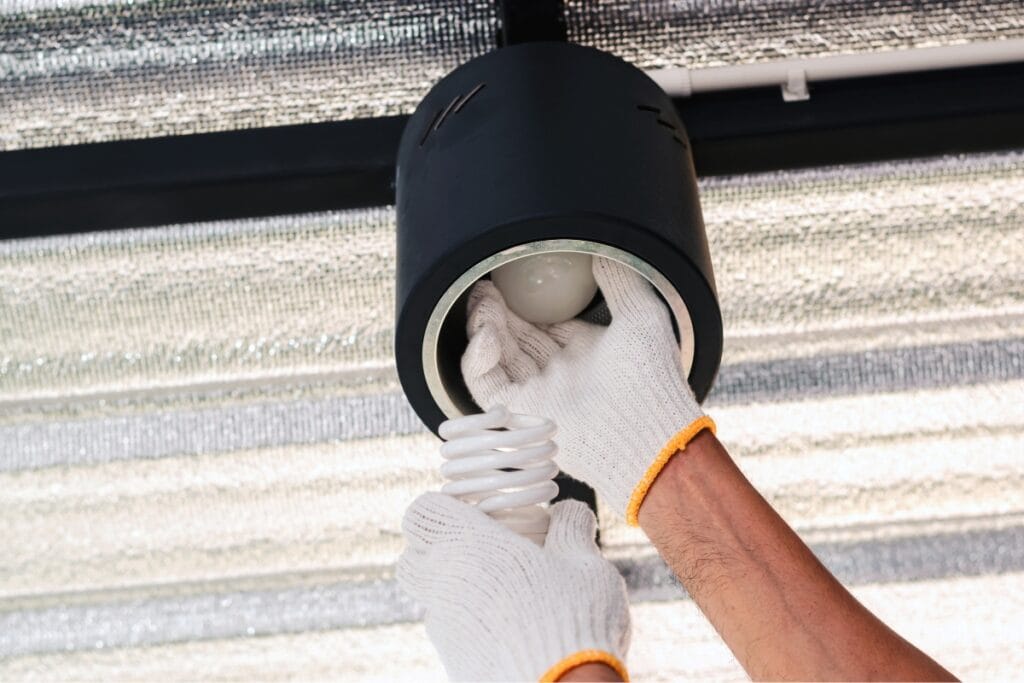
To keep your landscape lighting system in top shape, regular maintenance is crucial. You’ll need to clean and inspect fixtures, replace bulbs, and address wiring issues as they arise. Stay current with new technology updates, adjust your lighting for seasonal changes, and schedule professional checks. These steps ensure your system continues to enhance both safety and aesthetics year-round.
Regular Cleaning and Fixture Inspection
You should regularly clean and inspect your landscape lighting fixtures to maintain their effectiveness and longevity. Start by gently wiping down each fixture with a damp cloth to remove dirt and debris.
Check for any signs of wear, such as cracked lenses or corroded metal parts, which could compromise the fixture’s performance and safety.
During your inspection, pay close attention to wiring connections and ensure they’re secure and free from damage. Look for any moisture buildup inside the fixtures, as this can lead to electrical issues. If you notice any problems, address them promptly to prevent further damage and maintain your lighting system’s integrity:
Replacing Bulbs and Addressing Wiring Issues
When replacing bulbs in your landscape lighting system, opt for LED options to improve energy efficiency and longevity. Check the voltage requirements of your fixtures and choose bulbs that match. If you notice dim or flickering lights, it might indicate wiring issues that need attention.
Address wiring problems promptly to maintain your system’s safety and effectiveness. Look for signs of wear or damage on exposed wires, and ensure all connections are tight and corrosion-free. If you’re uncomfortable working with electrical components, consider hiring a professional to handle complex wiring issues:
Updating Systems With New Technology
You can update your landscape lighting system with new technology to enhance its efficiency and functionality.
Consider upgrading to smart LED bulbs that allow you to control brightness and color temperature from your smartphone. These modern fixtures often integrate with home automation systems, giving you greater control over your outdoor lighting.
As you update your system, explore motion sensor technologies that can improve security while conserving energy. You might also consider adding photocell sensors that automatically adjust your lights based on ambient light levels.
These upgrades not only boost your home’s safety features but also contribute to a more eco-friendly and cost-effective lighting solution.
Adjusting Lighting for Seasonal Changes
You should adjust your landscape lighting for seasonal changes to maintain optimal safety and aesthetics year-round. As daylight hours shift, update your timer settings to ensure lights activate at the appropriate times. During winter, consider increasing brightness levels to compensate for snow reflection and earlier sunsets.
In summer, you may want to reduce lighting intensity to create a softer ambiance and conserve energy. Adjust fixture angles to account for changes in foliage density, ensuring key areas remain well-lit throughout the year.
Regular seasonal adjustments will help you maintain effective security lighting while adapting to changing environmental conditions:
- Update timer settings with changing daylight hours
- Increase brightness in winter for better visibility
- Reduce intensity in summer for energy conservation
- Adjust fixture angles to account for foliage changes
Scheduling Professional Maintenance Checks
You should schedule professional maintenance checks for your landscape lighting system at least once a year. These expert inspections can identify potential issues before they become major problems, ensuring your lighting continues to provide optimal safety and security.
During these checks, professionals can clean hard-to-reach fixtures, test electrical components, and adjust light positioning for maximum effectiveness.
Consider scheduling these maintenance visits in the fall to prepare your system for the longer winter nights. Professional technicians can winterize your lighting, replace worn components, and update your system with the latest energy-efficient technologies.
These regular check-ups not only extend the lifespan of your lighting system but also help maintain its performance throughout the year:
- Annual professional inspections
- Fall maintenance to prepare for winter
- Cleaning of hard-to-reach fixtures
- Electrical component testing
- System updates and energy efficiency improvements
Frequently Asked Questions
How does landscape lighting improve home security?
Landscape lighting enhances home security by illuminating dark areas, deterring intruders, and creating the impression of an occupied home. Strategic placement of lights along pathways, entrances, and potential hiding spots increases visibility and safety, making your property less attractive to criminals.
What are the key principles of effective landscape lighting design?
Effective landscape lighting design balances functionality and aesthetics. Key principles include highlighting focal points, creating depth, ensuring safety, using layered lighting, controlling glare, and considering energy efficiency. Proper placement and fixture selection enhance your outdoor space‘s beauty and usability after dark.
Which lighting techniques work best for different areas of my property?
For your property, consider uplighting trees and architectural features, path lighting for walkways, and downlighting for patios. Soft ambient lighting works well in gathering areas, while task lighting is ideal for outdoor kitchens. Waterproof fixtures are essential for pool areas and water features.
What types of lighting fixtures are most effective for security purposes?
Motion-activated floodlights and LED spotlights are highly effective for security lighting. These fixtures provide bright illumination, deter intruders, and conserve energy. Strategic placement around entry points, driveways, and dark areas of your property enhances overall security and visibility.
Should I hire a professional or install landscape lighting myself?
While DIY landscape lighting can be tempting, hiring a professional ensures proper installation, optimal design, and safety compliance. Legacy Landscape Design‘s experts can create a custom lighting plan that enhances your outdoor space‘s beauty and functionality, saving you time and potential headaches in the long run.
Conclusion
Expert landscape lighting design plays a crucial role in enhancing home safety and security by deterring intruders, illuminating entry points, and preventing accidents. Investing in professional landscape lighting design not only boosts property value but also provides peace of mind, making it an essential consideration for any homeowner prioritizing safety and aesthetics.
Illuminate your home with expertly designed landscape lighting that not only enhances its beauty but also boosts safety and security. At Legacy Landscape Design, we specialize in expert installation services tailored to your needs, ensuring your property is both welcoming and well-protected. Contact us today at 770-427-2026 or get in touch through our contact form. Let us help you transform your outdoor space into a stunning and secure haven!
